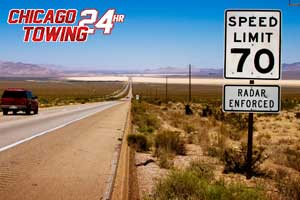When utilizing a trailer, as many people do during the Holiday Season, drivers need to be aware of the speed limit in order to maintain safety. Trailers and caravans have different speed limit needs than the typical car or sedan; here’s a guide to safely driving trailers and caravans, as prepared by the towing and highway safety experts here at Towing Chicago.
Single Lane Highway Trailer Driving
This type of highway requires drivers to hold to the far right side of the road, so that drivers behind you won’t coalesce into traffic due to your slower driving speed. The usual speed limit on single lane highways are around 60-70 miles per hour for the typical car, so any trailers will need to be slowed down about 10 miles per hour below the high end of the limit. Hence, if the maximum speed limit for normal cars is 65 miles per hour, you will need to drive at 55 miles per hour, maximum. Due to the difference in driving speed between you and other drivers on the road, you will likely experience having cars tailing behind you; simply pull over and let them pass you- in fact, some States consider it a traffic crime to hold cars up behind you in a line!
Two-Side Divided Highway Trailer Driving
These highways require a different trailer driving approach. Since there’s two sides of the road, it’s less likely that other drivers will get stuck behind your trailer as it is when driving on a single lane highway. However, you will still need to drive at least 10 miles per hour under the speed limit on this road. However, based on what State you’re driving in, you will be able to drive faster, due to the higher speed limits that allow you to drive between 60 and 70 miles per hour still while towing your trailer. It’s important to say, however, that even if driving this fast is legal, it’s not always safe or a good idea – especially in inclement weather like rain or snow. It’s also essential to remember never to drive in the second lane of the highway, unless there’s an obstruction in the far right lane.
Freeway Trailer Driving
These multiple laned driving planes are built to limit traffic. The usual speed limit for trailers on freeways varies by State, and can reach about 65-70 miles per hour. If you’re traveling between States, it’s smart to look up the trailer traffic laws based on each State you will be driving through. Even on freeways, you will still need to stay within the speed limit and the far right lane, as well as staying aware of all other drivers around you at all times. It’s also important to know that the majority of States (38 of them) prohibit passengers to ride inside the trailer while it’s being towed on freeways, so make sure there’s enough room in your car to transport all of your passengers before embarking out on the freeway.

